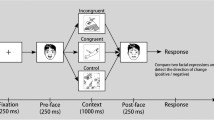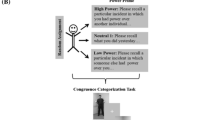Abstract
Facial expressions of emotion (FEEs) have been portrayed as potent (dis-) incentives for power-motivated perceivers, because they signal the strength of a sender’s dominance (Stanton et al. in Implicit motives. Oxford University Press, New York, pp 245–278, 2010). Here, we tested the hypothesis that individuals with a high implicit power motive (nPower), who have a disposition to seek (emotional) impact on others, would be faster at recognizing FEEs than individuals low in nPower. In a task employing videos of morphed FEEs, which are gradually changing from neutral to either anger, joy or surprise, higher nPower predicted faster recognition of the displayed emotion as well as a tendency to misidentify joy as anger. Our findings suggest that one way through which people high in nPower are socially influential is their enhanced sensitivity to emotional signals in their social environment.


Similar content being viewed by others
References
Adelmann, P. K., & Zajonc, R. B. (1989). Facial efference and the experience of emotion. Annual Review of Psychology, 40(1), 249–280.
Baron-Cohen, S., Wheelwright, S., Hill, J., Raste, Y., & Plumb, I. (2001). The “Reading the Mind in the Eyes” test revised version: A study with normal adults, and adults with Asperger syndrome or high-functioning autism. Journal of Child Psychology and Psychiatry, 42(2), 241–251.
Borsboom, D., Mellenbergh, G. J., & van Heerden, J. (2004). The concept of validity. Psychological Review, 111, 1061–1071.
Ekman, P., Friesen, W. V., & Hager, J. C. (2002). Facial action coding system. The manual on CD ROM. Salt Lake City, UT: Research Nexus.
Ekman, P., & O’Sullivan, M. (1991). Who can catch a liar? American Psychologist, 46(9), 913–920.
Fodor, E. M., & Carver, R. A. (2000). Achievement and power motives, performance feedback, and creativity. Journal of Research in Personality, 34(4), 380–396. doi:10.1006/jrpe.2000.2289.
Fodor, E. M., Wick, D. P., & Hartsen, K. M. (2006). The power motive and affective response to assertiveness. Journal of Research in Personality, 40(5), 598–610.
Hall, J., Andrzejewski, S., & Yopchick, J. (2009). Psychosocial correlates of interpersonal sensitivity: A meta-analysis. Journal of Nonverbal Behavior, 33(3), 149–180.
Hareli, S., Shomrat, N., & Hess, U. (2009). Emotional versus neutral expressions and perceptions of social dominance and submissiveness. Emotion, 9(3), 378–384.
Hess, U., Blairy, S., & Kleck, R. E. (2000). The influence of facial emotion displays, gender, and ethnicity on judgments of dominance and affiliation. Journal of Nonverbal Behavior, 24, 265–283.
Keltner, D., Gruenfeld, D. H., & Anderson, C. (2003). Power, approach, and inhibition. Psychological Review, 110(2), 265–284.
Knutson, B. (1996). Facial expressions of emotion influence interpersonal trait inferences. Journal of Nonverbal Behavior, 20(3), 165–182.
Köllner, M. G., & Schultheiss, O. C. (2014). Meta-analytic evidence of low convergence between implicit and explicit measures of the needs for achievement, affiliation, and power. Frontiers in Psychology, 5, 826.
McClelland, D. C. (1987). Human motivation. New York: Cambridge University Press.
McClelland, D. C., & Boyatzis, R. E. (1982). Leadership motive pattern and long-term success in management. Journal of Applied Psychology, 67, 737–743.
McClelland, D. C., & Burnham, D. H. (1976). Power is the great motivator. Harvard Business Review, 54, 100–110.
N’Diaye, K., Sander, D., & Vuilleumier, P. (2009). Self-relevance processing in the human amygdala: Gaze direction, facial expression, and emotion intensity. Emotion, 9(6), 798–806.
Rawolle, M., Schultheiss, M., & Schultheiss, O. C. (2013). Relationships between implicit motives, self-attributed motives, and personal goal commitments. Frontiers in Psychology, 4, 923.
Rösch, A. G., & Schultheiss, O. C. (n.d.). The standardized and motivated facial expression of emotion (SMoFEE) stimulus set: I. Evaluation of expressive and perceptual validity (in preparation).
Schultheiss, O. C. (2008). Implicit motives. In O. John, R. Robins, & L. Pervin (Eds.), Handbook of personality: Theory and research (3rd ed., pp. 603–633). New York: Guilford.
Schultheiss, O. C., & Brunstein, J. C. (2002). Inhibited power motivation and persuasive communication: A lens model analysis. Journal of Personality, 70(4), 553–582.
Schultheiss, O. C., & Hale, J. A. (2007). Implicit motives modulate attentional orienting to facial expressions of emotion. Motivation and Emotion, 31(1), 13–24.
Schultheiss, O. C., & Pang, J. S. (2007). Measuring implicit motives. In R. W. Robins, C. Fraley, & R. Krueger (Eds.), Handbook of research methods in personality psychology (pp. 322–344). New York: Guilford.
Schultheiss, O. C., Pang, J. S., Torges, C. M., Wirth, M. M., & Treynor, W. (2005). Perceived facial expressions of emotion as motivational incentives: Evidence from a differential implicit learning paradigm. Emotion, 5(1), 41–54.
Schultheiss, O. C., Wirth, M. M., & Stanton, S. J. (2004). Effects of affiliation and power motivation arousal on salivary progesterone and testosterone. Hormones and Behavior, 46(5), 592–599.
Schultheiss, O. C., Wirth, M. M., Waugh, C. E., Stanton, S. J., Meier, E. A., & Reuter-Lorenz, P. (2008). Exploring the motivational brain: effects of implicit power motivation on brain activation in response to facial expressions of emotion. Social Cognitive and Affective Neuroscience, 3(4), 333–343.
Schultheiss, O. C., Yankova, D., Dirlikov, B., & Schad, D. J. (2009). Are implicit and explicit motive measures statistically independent? A fair and balanced test using the picture story exercise and a cue- and response-matched questionnaire measure. Journal of Personality Assessment, 91(1), 72–81.
Spangler, W. D. (1992). Validity of questionnaire and TAT measures of need for achievement: Two meta-analyses. Psychological Bulletin, 112(2), 140–154.
Stanton, S. J., Hall, J. L., & Schultheiss, O. C. (2010). Properties of motive-specific incentives. In O. C. Schultheiss & J. C. Brunstein (Eds.), Implicit motives (pp. 245–278). New York: Oxford University Press.
Wang, J., Liu, L., & Yan, J. H. (2014). Implicit power motive effects on the ERP processing of emotional intensity in anger faces. Journal of Research in Personality, 50, 90–97.
Wang, J., Liu, L., & Zheng, Y. (2011). Effects of implicit power motive on the processing of anger faces: An event-related potential study. Journal of Research in Personality, 45(5), 441–447.
Winter, D. G. (1988). The power motive in women—And men. Journal of Personality and Social Psychology, 54(3), 510–519.
Winter, D. G. (1994). Manual for scoring motive imagery in running text (4th ed.). Department of Psychology, University of Michigan, Ann Arbor: Unpublished manuscript.
Winter, D. G. (2010). Political and historical consequences of implicit motives. In Implicit motives (pp. 407–432).
Acknowledgments
This work was supported by Deutsche Forschungsgemeinschaft [grant SCHU 1210/3-1] awarded to Oliver C. Schultheiss and Andreas G. Rösch and a McClelland Fellowship of the McClelland Center for Research and Innovation (Hay Group) awarded to Andreas G. Rösch.
Author information
Authors and Affiliations
Corresponding author
Rights and permissions
About this article
Cite this article
Donhauser, P.W., Rösch, A.G. & Schultheiss, O.C. The implicit need for power predicts recognition speed for dynamic changes in facial expressions of emotion. Motiv Emot 39, 714–721 (2015). https://doi.org/10.1007/s11031-015-9484-z
Published:
Issue Date:
DOI: https://doi.org/10.1007/s11031-015-9484-z




